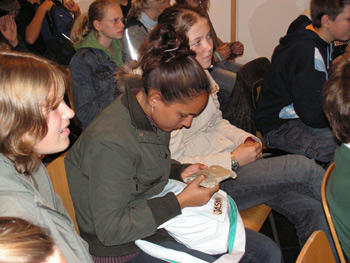Edubba - Academic Outreach for Schools
“In the beginning there was the wedge.” School children in Mesopotamia learned these words on their first day of school more than 4000 years ago. The school was then called the Edubba, literally the “House of tablets.” The cradle of civilization in ancient Mesopotamia brought forth some of the most important developments in human history, which still shape our world today. These include the first sedentary settlements, the first great cities, the first writing, and the first mathematics. The curricula of our schools, however, rarely have time to devote more than a few lessons, if at all, to these important innovations.
The Institute of Ancient Near Eastern Studies offers classes for schools from the 3rd to 8th grades in order to provide a first look into Mesopotamian history and culture. The exact program depends on the individual grades and is attended to supplement the lesson plans for social studies, mathematics, history, or language. Previous classes have focused on the following topics:
- The Invention of Cuneiform (3rd to 6th grades): How did people begin to write over 5000 years ago? The students discover the first writing system in world history as it develops from early pictograms to a full-fledged logographic and syllabic script. They can compare the advantages (and disadvantages) compared to the alphabet. In higher grades, the students can also explore related cultural and historical topics: Under what conditions was cuneiform first developed, who could read and write, and who was allowed to attend school? Supplied with stylus, clay, and sign list, the students can appy what they've learned by writing their own cuneiform tablets.
- Cuneiform Mathematics (5th to 6th grades): Why do we write our numbers they way we do? The students can gain a better understanding of how mathematics developed. The class covers the writing of numbers in cuneiform, the sexagesimal system as a place value system with its various advantages and disadvantages, and the Mesopotamian background of modern time keeping as well as simple mathematical calculations.
- Cuneiform Mathematics for Advanced Grades (6th to 8th grades): How did mathematics work in ancient Mesopotamia? Many of the basics of modern mathematics can be traced back to Mesopotamian precursors. The class provides an introduction to the sexagesimal system and its application in practical word problems, ending with the Mesopotamian version of one of the most famous theorems of geometry: the Pythagorean theorem.
Classes offered regularly by prior arrangement during the semester breaks. Each class covers approximately three hours of instruction with intermittent breaks/recess, usually from 10 AM to 1 PM.
Further Information
Institut für Altorientalistik, Fabeckstr. 23 – 25, 14195 Berlin Tel. 83853347,
email: altorientalistik@geschkult.fu-berlin.de


